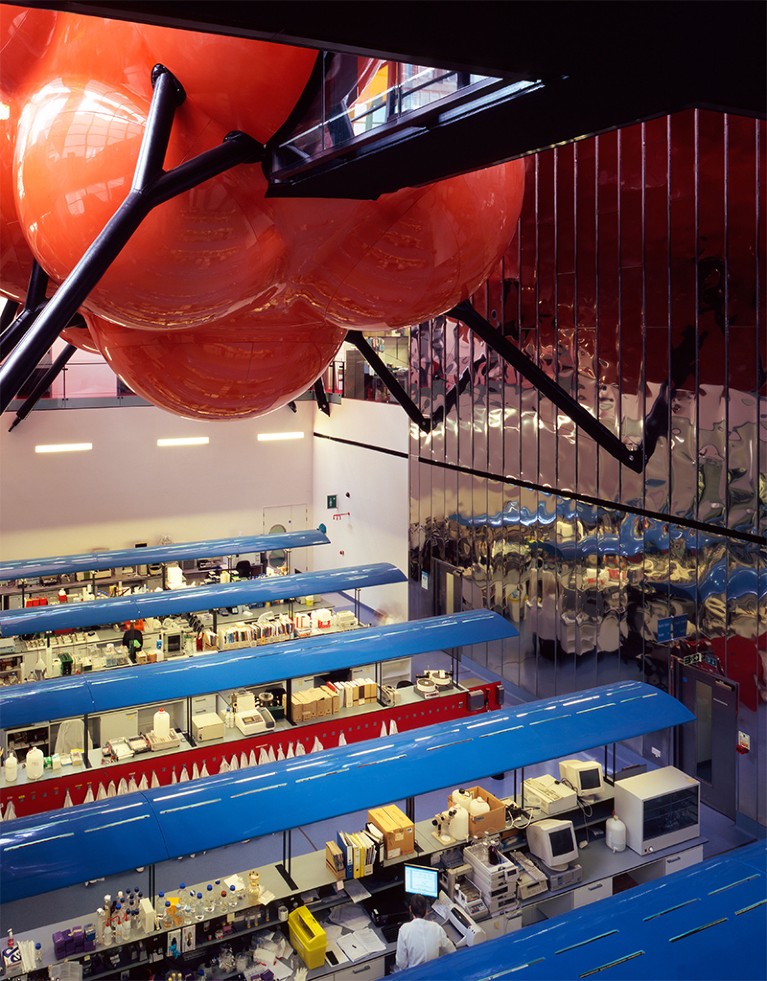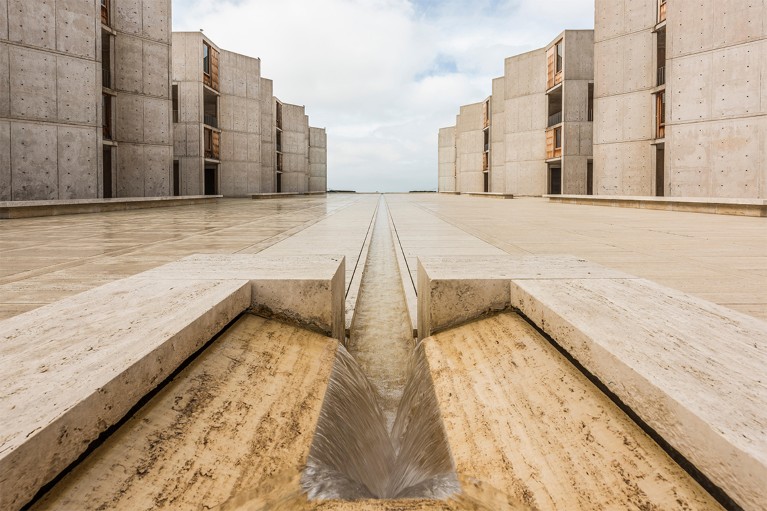Laboratory Lifestyles: The Construction of Scientific Fictions Sandra Kaji‑O’Grady, Chris L. Smith and Russell Hughes MIT Press (2019)
From the Francis Crick Institute in London to Japan’s Okinawa Institute of Science and Technology, much has been made of how architecture influences scientists’ work. That is, how sunlit benches help researchers’ mental health; how cushy breakout spaces spark spontaneous collaboration; and how walking trails and yoga classes rebalance workaholic tendencies. Indeed, many who work in academic and corporate science agree that built-in amenities add productivity.
As someone who has chronicled scientists’ lives for Nature and other media outlets for nearly two decades, I’ve heard a great deal about the power of place to boost or sap the will of postdocs and principal investigators. But, as a former cell biologist, I want to see the data. So I picked up Laboratory Lifestyles with some anticipation.
What I found was a book that, although not strong on data, offers an agreeable, sometimes surprising journey through the history and trends of laboratories built around lifestyle — scientists’ conversations, proclivities and interactions, not just their apparatus. Edited by Australia-based architecture scholars Sandra Kaji-O’Grady, Chris Smith and Russell Hughes, the journey begins in the 1950s and 1960s in California, then, as now, a magnet for science. An early chapter showcases how the southern Californian lifestyle of surfing and outdoor living crept into the design of the RAND Corporation’s original ‘waffle’ building in Santa Monica, and the sweeping ocean-to-mountain vistas of the Hughes Research Laboratories in Malibu. The ‘work hard, play hard’ mantra guided coastal California’s deep thinkers long before biotechnology company Genentech and its amenity-fuelled approach to research arrived in South San Francisco.
Open-plan innovation
The book rightly dwells on the architectural breakthrough of Louis Kahn’s 1963 Salk Institute for Biological Studies in La Jolla, California, with its imposing concrete facades, teak accents and white travertine marble courtyard. That bold facade was intended to lure star scientists, philanthropists and partners, and engage the public. It has done all this. When I was a graduate student there, the views of paragliders over the Pacific Ocean and the sea breezes lifted my spirits amid the worst experimental fails. What I did not understand then was the Salk’s real breakthrough: its open-plan lab benches, crafted to encourage conversations and enable easy rearrangements as science evolved. Soon, this innovation was adopted the world over. (The book does not cover more-controversial aspects of the Salk’s configuration: its separation of senior and junior staff, for instance, has been criticized as elitist.)
Contributors Kathleen Brandt and Brian Lonsway take us to the early 1970s with Xerox’s Palo Alto Research Center (PARC) conference room, a haven decked with then-novel beanbag chairs and whiteboard walls instead of a conference table. Set in the then-nascent Silicon Valley, PARC’s output was attributed as much to its culture as to the talent it attracted. Its ‘creative hive’ atmosphere has since been recreated, with heavy investment, at workplaces ranging from Google to biotech up-and-comer Moderna Therapeutics in Cambridge, Massachusetts. But did the beanbags boost productivity? The authors write that it is “impossible to prove causality”. Given that establishing causalities is scientists’ lifeblood, the lack of evidence that the hipster-hub aesthetic actually recruits, retains or spurs innovators is alarming.
In the 2000s, eminent architects created lab buildings for two companies in Basel, Switzerland — Actelion (designed by Herzog and de Meuron) and Novartis (Frank Gehry, among others) — along with Singapore’s science-hub campus one-north (the late Zaha Hadid). Funky, illuminating facades take centre stage in these edifices in a bid to attract venture capitalists and encourage breakthroughs.
Social experiment
The authors argue that this trend towards ‘luxe labs’ is a grand social experiment, with scientists as guinea pigs. They veer into an ethnographic study of researchers and their relationships to these buildings and breakout spaces, eavesdropping on their lunch conversations. They often cite the 1979 book Laboratory Life by sociologists Bruno Latour and Steve Woolgar, who shadowed Salk staff like anthropologists, and argued that scientists’ social interactions govern which lines of enquiry are ultimately pursued.
Scientists, however, are everyday humans. Do they need lavish surroundings or unusual furniture to trigger intellectual discussion?

The Blizard Building at Queen Mary University of London has sunken labs and elevated meeting pods.Credit: Richard Brine-VIEW/Alamy
The designers of the Blizard Building, the biomedical hub of Queen Mary University of London, certainly thought so. Among its fantastical architectural elements are “mushroom”, “cloud” and “spikey” pods serving as meeting and lounge spaces that “hover over the subterranean laboratories below”. The lab benches are standard, but sunken. I imagine researchers’ annoyance at climbing stairs to get to their nearby desks, or wondering over the whimsical meeting spaces, when a few tables by the large windows would do.
Where’s the evidence?
It is all very well for the physicists at the Perimeter Institute in Waterloo, Canada, to feel they can scribble on the vast windows, but spaces where experiments happen must be practical and utilitarian. And contemplation can occur anywhere — in the shower, on a commute, while hiking (the Santa Fe Institute in New Mexico, set among hills and thermal pools, appreciates this). So far, no one has investigated whether Google engineers zipping around on Razor scooters to Lego-building stations innovate more freely than do their counterparts at more strait-laced firms.
In general, there seems to be a notable lack of consultation between architects and people who will work in their creations. One exception is the 2015 National Graphene Institute (NGI) on the campus of the University of Manchester, UK. Designers collaborated with institute researchers to yield a beautiful, functional building with easily adaptable clean rooms and other lab spaces enclosed by glass that invite both light and transparency around the work. Contributors Albena Yaneva and Stelios Zavos conclude that the NGI’s labs actively shape and regulate the research culture, promoting “ecologies of innovation”, and “new alliances of science, society, and industry”.
But the authors’ own photos show atria and plentiful couches devoid of humans (although they probably make nice napping platforms for overworked postdocs). Without evidence, it is an over-reach to say that the building’s design accomplishes these grand goals.
I really wanted to see a controlled study on the nexus of built environment and research productivity. How difficult would it be to compare the output from researchers in the sleek NGI with that of those in an antiquated Manchester lab? Or to see whether Salk scientists in sunny La Jolla have made more breakthroughs than their counterparts in dreary basement labs at Mayo Clinic in Rochester, Minnesota?
Stranger even is the assertion at the end of Laboratory Lifestyles: that the dawn of the “petabyte age” of big data will make scientists and their hypotheses — and presumably labs — obsolete. Is this book an exploration of the lab or a prediction of its demise? In any case, it throws considerable doubt on whether some prominent lab architects understand the very passions that make lab occupants tick.


 The Crick Institute unpeeled
The Crick Institute unpeeled
 The chemistry chronicles
The chemistry chronicles
 Crucible of science
Crucible of science
 A lab of one's own
A lab of one's own







